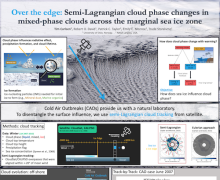Over the edge: Semi-Lagrangian cloud phase changes in Antarctic mixed-phase clouds across the marginal sea ice zone
Tim
Carlsen
University of Oslo
Poster
The amount of supercooled liquid and ice within mixed-phase clouds (MPCs) influences precipitation formation, cloud lifetime, and electrification. Simultaneously, the thermodynamic phase composition controls the radiative properties of MPCs due to the different scattering properties between liquid water and ice. The importance of better representing MPCs in Earth System Models for improving future climate projections is undisputed, but exactly how the balance between liquid and ice in high-latitude MPCs will change in a warming climate is still unclear. Until recently, they were believed to transition towards a state with more liquid water and a higher albedo, which would limit future warming (cloud phase feedback). However, recent studies suggest that due to retreating sea ice, local marine sources of ice-nucleating particles (INPs) – the prerequisite for ice formation at temperatures warmer than -38°C – will become more abundant, leading to more ice in the clouds. Understanding these complex interactions between clouds, sea ice, open ocean and radiation are of paramount importance for accurately predicting future climate change.
In this regard, cold air outbreaks can provide a natural laboratory to study the influence of sea ice on the ice formation within Polar MPCs. The rapid change in surface fluxes, moisture and INP availability will in turn drive changes in the cloud phase. In order to disentangle the different processes of ice formation, in this study we track the clouds in a semi-Lagrangian way from polar-orbiting satellites as they transition from sea ice to open ocean. In particular, we combine more than 5600 overpasses of CloudSat and CALIPSO over the cloudy sea ice edge between 2006 and 2010. The combined 2B-CLDCLASS-lidar product, which merges the Cloud Profiling Radar on CloudSat and the Cloud-Aerosol Lidar with Orthogonal Polarization (CALIOP) on CALIPSO, enables us to distinguish between pure liquid and liquid-top MPCs. Together with cloud top temperatures from reanalysis data, we use the semi-Lagrangian statistics to contrast the transition temperature (T*) at which INPs are activated over both the sea ice and the open ocean.
We find that the distance from the sea ice edge serves as a good indicator for categorizing the phase composition of MPCs in the Polar regions, and that the open ocean is an important source of INPs, fostering primary ice nucleation at warmer temperatures. The presented characterization of the phase transition of MPCs as they cross the sea ice edge provides an important stepping stone for improving estimates of the mixed-phase cloud feedback.
Here we focus on the Antarctic region, where recently an unprecedented decline in sea ice has been observed. Our investigation of the interlink between sea ice, open ocean, cloud phase and radiation will help understand future cloud phase feedback changes should this sea ice retreat continue.
In this regard, cold air outbreaks can provide a natural laboratory to study the influence of sea ice on the ice formation within Polar MPCs. The rapid change in surface fluxes, moisture and INP availability will in turn drive changes in the cloud phase. In order to disentangle the different processes of ice formation, in this study we track the clouds in a semi-Lagrangian way from polar-orbiting satellites as they transition from sea ice to open ocean. In particular, we combine more than 5600 overpasses of CloudSat and CALIPSO over the cloudy sea ice edge between 2006 and 2010. The combined 2B-CLDCLASS-lidar product, which merges the Cloud Profiling Radar on CloudSat and the Cloud-Aerosol Lidar with Orthogonal Polarization (CALIOP) on CALIPSO, enables us to distinguish between pure liquid and liquid-top MPCs. Together with cloud top temperatures from reanalysis data, we use the semi-Lagrangian statistics to contrast the transition temperature (T*) at which INPs are activated over both the sea ice and the open ocean.
We find that the distance from the sea ice edge serves as a good indicator for categorizing the phase composition of MPCs in the Polar regions, and that the open ocean is an important source of INPs, fostering primary ice nucleation at warmer temperatures. The presented characterization of the phase transition of MPCs as they cross the sea ice edge provides an important stepping stone for improving estimates of the mixed-phase cloud feedback.
Here we focus on the Antarctic region, where recently an unprecedented decline in sea ice has been observed. Our investigation of the interlink between sea ice, open ocean, cloud phase and radiation will help understand future cloud phase feedback changes should this sea ice retreat continue.

carlsen-tim-polar-poster.pdf
(1.14 MB)
